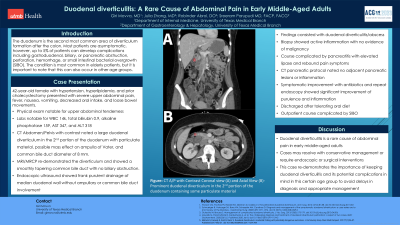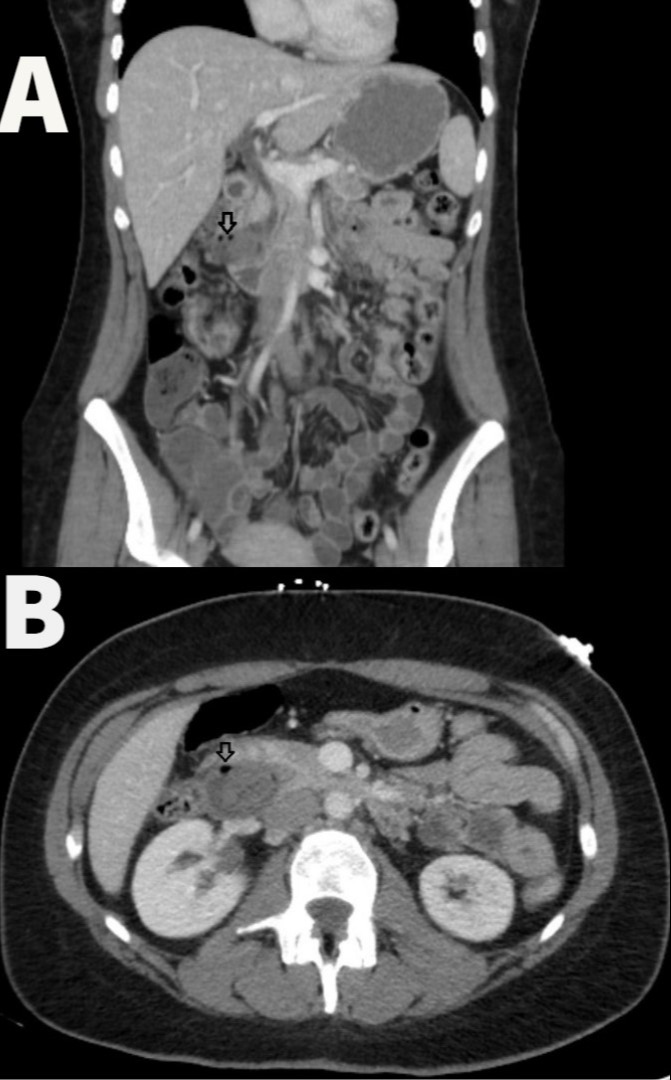Monday Poster Session
Category: Small Intestine
P2683 - Duodenal Diverticulitis: A Rare Cause of Abdominal Pain in Early Middle Age Adults
Monday, October 23, 2023
10:30 AM - 4:15 PM PT
Location: Exhibit Hall

Has Audio
- GM
Giri Movva, MD
University of Texas Medical Branch
Galveston, TX
Presenting Author(s)
Giri Movva, MD, Julia Zhang, MD, Robinder Abrol, DO, Sreeram Parupudi, MD
University of Texas Medical Branch, Galveston, TX
Introduction: The duodenum is the second most common area of diverticulum formation after the colon. Most patients are asymptomatic, however, up to 5% of patients can develop complications including gastroduodenal, biliary or pancreatic obstruction, perforation, hemorrhage or small intestinal bacterial overgrowth (SIBO). The condition is most common in elderly patients, but it is important to note that this can also occur in other age groups.
Case Description/Methods: A 42-year-old female with hypertension, hyperlipidemia, and prior cholecystectomy presented with severe upper abdominal pain, fever, nausea, vomiting, decreased oral intake, and loose bowel movements. She had upper abdominal tenderness on exam and notable labs included WBC 14k, total bilirubin 0.9, alkaline phosphatase 159, AST 347, and ALT 318. Computed Tomography (CT) abdomen and pelvis with contrast noted a large duodenal diverticulum in the 2nd portion of the duodenum with particulate material, possible mass effect on the ampulla of Vater, and common bile duct diameter of 8 mm. Magnetic Resonance Imaging/Magnetic Resonance Cholangiopancreatography (MRI/MRCP) re-demonstrated the diverticulum and showed a smoothly tapering common bile duct with no biliary obstruction. The patient was started on empiric antibiotics and nasogastric decompression. Endoscopic ultrasound showed frank purulent drainage of the median duodenal wall, without involvement of the ampullary opening or common bile duct, consistent with impacted duodenal diverticulitis/abscess. Biopsies showed active inflammation and no evidence of malignancy. The patient developed possible mild pancreatitis later during the admission with an elevation in lipase and rebound pain symptoms, likely related to adjacent duodenal inflammation. CT pancreatic protocol noted no adjacent pancreatic lesions or inflammation. The patient improved symptomatically with antibiotics and repeat endoscopy showed significant improvement in duodenal diverticulum inflammation and purulence. The patient was discharged after she tolerated an oral diet. Her outpatient course so far has been complicated by SIBO.
Discussion: Duodenal diverticulitis is a rare cause of abdominal pain in early middle-aged adults. Cases may resolve with conservative management or require endoscopic or surgical interventions. It is important to keep duodenal diverticulitis and its potential complications in mind in this age group to avoid delays in diagnosis and appropriate management.

Disclosures:
Giri Movva, MD, Julia Zhang, MD, Robinder Abrol, DO, Sreeram Parupudi, MD. P2683 - Duodenal Diverticulitis: A Rare Cause of Abdominal Pain in Early Middle Age Adults, ACG 2023 Annual Scientific Meeting Abstracts. Vancouver, BC, Canada: American College of Gastroenterology.
University of Texas Medical Branch, Galveston, TX
Introduction: The duodenum is the second most common area of diverticulum formation after the colon. Most patients are asymptomatic, however, up to 5% of patients can develop complications including gastroduodenal, biliary or pancreatic obstruction, perforation, hemorrhage or small intestinal bacterial overgrowth (SIBO). The condition is most common in elderly patients, but it is important to note that this can also occur in other age groups.
Case Description/Methods: A 42-year-old female with hypertension, hyperlipidemia, and prior cholecystectomy presented with severe upper abdominal pain, fever, nausea, vomiting, decreased oral intake, and loose bowel movements. She had upper abdominal tenderness on exam and notable labs included WBC 14k, total bilirubin 0.9, alkaline phosphatase 159, AST 347, and ALT 318. Computed Tomography (CT) abdomen and pelvis with contrast noted a large duodenal diverticulum in the 2nd portion of the duodenum with particulate material, possible mass effect on the ampulla of Vater, and common bile duct diameter of 8 mm. Magnetic Resonance Imaging/Magnetic Resonance Cholangiopancreatography (MRI/MRCP) re-demonstrated the diverticulum and showed a smoothly tapering common bile duct with no biliary obstruction. The patient was started on empiric antibiotics and nasogastric decompression. Endoscopic ultrasound showed frank purulent drainage of the median duodenal wall, without involvement of the ampullary opening or common bile duct, consistent with impacted duodenal diverticulitis/abscess. Biopsies showed active inflammation and no evidence of malignancy. The patient developed possible mild pancreatitis later during the admission with an elevation in lipase and rebound pain symptoms, likely related to adjacent duodenal inflammation. CT pancreatic protocol noted no adjacent pancreatic lesions or inflammation. The patient improved symptomatically with antibiotics and repeat endoscopy showed significant improvement in duodenal diverticulum inflammation and purulence. The patient was discharged after she tolerated an oral diet. Her outpatient course so far has been complicated by SIBO.
Discussion: Duodenal diverticulitis is a rare cause of abdominal pain in early middle-aged adults. Cases may resolve with conservative management or require endoscopic or surgical interventions. It is important to keep duodenal diverticulitis and its potential complications in mind in this age group to avoid delays in diagnosis and appropriate management.

Figure: Figure 1: CT Abdomen and Pelvis with Contrast Coronal View (A) and Axial View (B)- Prominent duodenal diverticulum in the second portion of the duodenum containing some particulate material.
Disclosures:
Giri Movva indicated no relevant financial relationships.
Julia Zhang indicated no relevant financial relationships.
Robinder Abrol indicated no relevant financial relationships.
Sreeram Parupudi indicated no relevant financial relationships.
Giri Movva, MD, Julia Zhang, MD, Robinder Abrol, DO, Sreeram Parupudi, MD. P2683 - Duodenal Diverticulitis: A Rare Cause of Abdominal Pain in Early Middle Age Adults, ACG 2023 Annual Scientific Meeting Abstracts. Vancouver, BC, Canada: American College of Gastroenterology.
